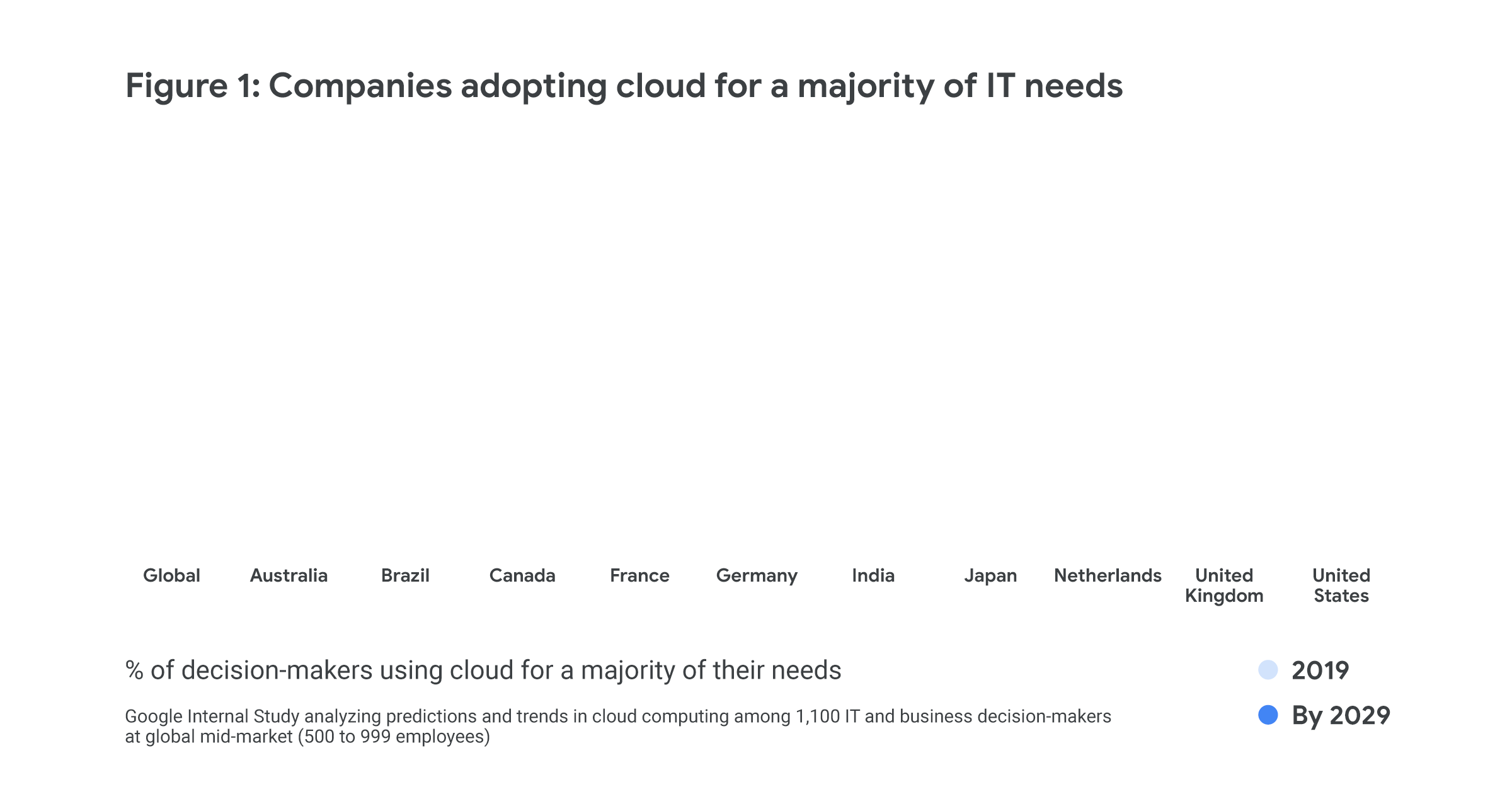Research shows that cloud computing will transform every aspect of business, from logistics to customer relationships to the way teams work together, and today’s organizations are preparing for this seismic shift. A new report from Google on the future of cloud computing combines an in-depth look at how the cloud is shaping the enterprise of tomorrow with actionable advice to help today’s leaders unlock its benefits. Along with insights from Google luminaries and leading companies, the report includes key findings from a research study that surveyed 1,100 business and IT decision-makers from around the world. Their responses shed light on the rapidly evolving technology landscape at a global level, as well as variations in cloud maturity and adoption trends across individual countries. Here are five themes that stood out to us from this brand-new research.1. Cloud computing will move to the forefront of enterprise technology over the next decade, backed by strong executive support.Globally, 47 percent of survey participants said that the majority of their companies’ IT infrastructures already use public or private cloud computing. When we asked about predictions for 2029, that number jumped 30 percentage points. C-suite respondents were especially confident that the cloud will reign supreme within a decade: More than half anticipate that it will meet at least three-quarters of their IT needs, while only 40 percent of their non-C-suite peers share that view. What’s the takeaway? The cloud already plays a key role in enterprise technology, but the next 10 years will see it move to the forefront—with plenty of executive support. Here’s how that data breaks down around the world.2. The cloud is becoming a significant driver of revenue growth.Cloud computing helps businesses focus on improving efficiency and fostering innovation, not simply maintaining systems and status quos. So it’s not surprising that 79 percent of survey respondents already consider the cloud an important driver of revenue growth, while 87 percent expect it to become one within a decade. C-suite respondents were just as likely as their non-C-suite peers to anticipate that the cloud will play an important role in driving revenue growth in 2029. This tells us that decision-makers across global organizations believe their future success will hinge on their ability to effectively apply cloud technology.3. Businesses are combining cloud capabilities with edge computing to analyze data at its source.Over the next decade, the cloud will continue to evolve as part of a technology stack that increasingly includes IoT devices and edge computing, in which processing occurs at or near the data’s source. Thirty-three percent of global respondents said they use edge computing for a majority of their cloud operations, while 55 percent expect to do so by 2029. The United States lags behind in this area, with only 18 percent of survey participants currently using edge computing for a majority of their cloud operations, but that figure grew by a factor of 2.5 when respondents looked ahead to 2029. As more and more businesses extend the power and intelligence of the cloud to the edge, we can expect to see better real-time predictions, faster responses, and more seamless customer experiences.4. Tomorrow’s businesses will prioritize openness and interoperability.In the best cases, cloud adoption is part of a larger transformation in which new tools and systems positively affect company culture. Our research suggests that businesses will continue to place more value on openness over the next decade. By 2029, 41 percent of global respondents expect to use open-source software (OSS) for a majority of their software platform, up 14 percentage points from today. Predicted OSS use was nearly identical between IT decision-makers and their business-oriented peers, implying that technology and business leaders alike recognize the value of interoperability, standardization, freedom from vendor lock-in, and continuous innovation.5. On their journey to the cloud, companies are using new techniques to balance speed and quality.To stay competitive in today’s streaming world, businesses face growing pressure to innovate faster—and the cloud is helping them keep pace. Sixty percent of respondents said their companies will update code weekly or daily by 2029, while 37 percent said they’ve already adopted this approach. This tells us that over the next 10 years, we’ll see an uptick in the use of continuous integration and delivery techniques, resulting in more frequent releases and higher developer productivity.As organizations prepare for the future, they will need to balance the need for speed with maintaining high quality. Our research suggests that they’ll do so by addressing security early in the development process and assuming constant vulnerability so they’re never surprised. More than half of respondents said they already implement security pre-development, and 72 percent plan to do so by 2029.Cloud-based enterprises will also rely on automation to maintain quality and security as their operations become faster and more continuous. Seventy percent of respondents expect a majority of their security operations to be automated by 2029, compared to 33 percent today.Our Future of Cloud Computing report contains even more insights from our original research, as well as a thorough analysis of the cloud’s impact on businesses and recommended steps for unlocking its full potential. You can download it here.
Quelle: Google Cloud Platform

Published by